Toruń
| Toruń | |||
|---|---|---|---|
 Middle: Dąmbski family Palace, Bridge Gate, Nicolaus Copernicus Monument Bottom: Toruń's medieval Old Town panorama | |||
| |||
| Nickname(s): City of Angels, Gingerbread city, Copernicus Town | |||
| Motto: "Durabo" (Latin: "I will endure") | |||
 Toruń | |||
| Coordinates: 53°2′N 18°37′E / 53.033°N 18.617°E | |||
| Country |
| ||
| Voivodeship | Kuyavian-Pomeranian | ||
| County | city county | ||
| Established | 13th century | ||
| City rights | 1233 | ||
| Government | |||
| • Mayor | Michał Zaleski | ||
| Area | |||
| • City | 115.72 km2 (44.68 sq mi) | ||
| Elevation | 30 m (100 ft) | ||
| Population (2009) | |||
| • City | 205,934 | ||
| • Density | 1,800/km2 (4,600/sq mi) | ||
| • Metro | 297,646 | ||
| Time zone | CET (UTC+1) | ||
| • Summer (DST) | CEST (UTC+2) | ||
| Postal code | 87-100 to 87-120 | ||
| Area code(s) | +48 56 | ||
| Car plates | CT | ||
| Website | http://www.torun.pl/ | ||
Toruń [ˈtɔruɲ] (![]() ) (German: Thorn (
) (German: Thorn (![]() listen), Kashubian: Torń, Latin: Thorunium, see also: other names) is a city in northern Poland, on the Vistula River. Its population is 205,934 as of June 2009. Toruń is one of the oldest cities in Poland. The medieval old town of Toruń is the birthplace of the astronomer Nicolaus Copernicus.
listen), Kashubian: Torń, Latin: Thorunium, see also: other names) is a city in northern Poland, on the Vistula River. Its population is 205,934 as of June 2009. Toruń is one of the oldest cities in Poland. The medieval old town of Toruń is the birthplace of the astronomer Nicolaus Copernicus.
In 1997 the medieval part of the city was designated a UNESCO World Heritage Site. In 2007 the Old Town in Toruń was added to the list of Seven Wonders of Poland. National Geographic Polska rated the old town market and the Gothic town hall as one of the "30 Most Beautiful Places in the World." In 2010 Forbes magazine ranked Toruń as number one of the "Polish Cities Attractive for Business".[citation needed] In 2009 it was listed as one of the "Best Cities to Live in Poland", in a ranking published by Przekrój.[citation needed]
Previously it was the capital of the Toruń Voivodeship (1975–98) and the Pomeranian Voivodeship (1921–45). Since 1999, Toruń has been a seat of the self-government of the Kuyavian-Pomeranian Voivodeship and, as such, is one of its two capitals (together with Bydgoszcz). The cities and neighboring counties form the Bydgoszcz-Toruń twin city metropolitan area. In September 2004, Bydgoszcz Medical School joined Toruń's Nicolaus Copernicus University as its Collegium Medicum. The current Mayor of Toruń is Mr. Michał Zaleski.[1]
History
The first settlement in the vicinity is dated by archaeologists to 1100 BC (Lusatian culture).[2] During early medieval times, in the 7th through 13th centuries, it was the location of an old Slavonic settlement.[3]
In spring 1231 the Teutonic Knights crossed the river Vistula at the height of Nessau and established a fortress. On 28 December 1233, the Teutonic Knights Hermann von Salza and Hermann Balk,[4] signed the foundation charters for Thorn and Chełmno. The original document was lost in 1244. The set of rights in general is known as Kulm law. In 1236, due to frequent flooding,[5] it was relocated to the present site of the Old Town. In 1264 the adjacent New Town was founded. In 1280, the city (or as it was then, both cities) joined the mercantile Hanseatic League, and thus became an important medieval trade centre.

The First Peace of Thorn ending the Polish–Lithuanian–Teutonic War was signed in the city in February 1411. In 1440, the gentry of Thorn formed the Prussian Confederation, and in 1454 rose with the Confederation against the Monastic state of the Teutonic Knights in the Thirteen Years' War. The rebellious burghers destroyed the Teutonic castle in Thorn, marking the start of that war. After almost 200 years, the New and Old Towns amalgamated in 1454.The Thirteen Years' War ended in 1466 with the Second Peace of Thorn, in which the Teutonic Order ceded their control over western provinces, henceforth Royal Prussia. Toruń became part of Kingdom of Poland.

During the Great Northern War (1700–21), the restoration of Augustus the Strong as King of Poland was prepared in the town by Russian Tsar Peter the Great. In the second half of the 17th century, tensions between Catholics and Protestants grew, similarly to religious wars throughout Europe. In the early 18th century about 50 percent of the populace, especially the gentry and middle class, were German-speaking Protestants, while the other 50 percent were Polish speaking Roman Catholics.[6] Protestant influence was subsequently pushed back after the Tumult of Thorn of 1724.
In 1793 the Kingdom of Prussia annexed the city following the Second Partition of Poland. Toruń was part of the area subject to Prussian and later German attempts to Germanise the province. Toruń became a centre of resistance to Germanization and Kulturkampf by Poles, who established a Polish-language newspaper, Gazeta Toruńska.[3] According to the Treaty of Versailles following World War I in 1919, Toruń was part of the Polish Corridor assigned to Poland. German sources claim a German majority population up to the January 1920 transfer to Poland, when many Germans chose to leave. Polish statistics show the German share of the city's population collapse to 5% by 1926. During World War II, the German army entered the city on September 7, 1939. Nazi Germany annexed the city, and administered it as part of Danzig-West Prussia. By the end of November the city was declared Judenfrei, with several hundred Jews who chose to stay, deported to the Łódź Ghetto and other locations in the Warthegau.[7] Poles were classified as untermenschen by German authorities, with their fate being slave-labor, executions and expulsions. The Germans used the chain of forts surrounding the city as POW camps, known collectively as Stalag XX-A. After the war, it was returned to Poland. The remaining ethnic German population was expelled.
After World War II, the population increased more than twofold and industry developed significantly. The founding of the Nicolaus Copernicus University in 1945 was significant. Since 1989, when local and regional self-government was gradually reintroduced and the market economy was introduced, Toruń, like other cities in Poland, has undergone deep social and economic transformations. Toruń has recently reclaimed its strong position as a regional leader.
Etymology
Early documents refer to a settlement called Tarnowo. Other early names include Torun, Thorun, Turon, Turun, Toron, Thoron and Thorn.
Latin documents and coins usually spelled it Thorun, Thorunium, civitas Thorunensis, or civitas Torunensis, and after the 15th century, the current Polish name Toruń.
The two main hypothesis about the name's origins are
- It may come from the Polish word tor, which means "track (of the Vistula river)". Toruń would mean "town on the track".
- It may have been originally Tarnowo, based on the Polish word tarnina, a kind of river plant. There are many cities in Poland with a similar derivation.
Sights

Listed on the UNESCO list of World Heritage Sites since 1997, Toruń has many monuments of architecture beginning from the Middle Ages. The city is famous for having preserved almost intact its medieval spatial layout and many Gothic buildings, all built from brick, including monumental churches, the Town Hall and many burgher houses. The most interesting monuments are:

- Gothic churches:
- The Cathedral of SS. John the Evangelist and John the Baptist, an aisled hall church built in the 14th century and extended in the 15th century; outstanding Gothic sculptures and paintings inside (Moses, St. Mary Magdalene, gravestone of Johann von Soest), Renaissance and Baroque epitaphs and altars (among them the epitaph of Copernicus from 1580)
- St. Mary's church, a formerly Franciscan aisled hall built in the 14th century
- St. James's church (often mistakenly called St Jacob's), a basilica from the 14th century, with monumental wall paintings and Gothic stalls
- The Old Town Hall, begun in 1274, extended and rebuilt between 1391 and 1399, and extended at the end of the 16th century; one of the most monumental town halls in Central Europe
- City fortifications, begun in the 13th century, extended between the 14th and 15th centuries, mostly demolished in the 19th century, but partially preserved with a few city gates and watchtowers (among them the so-called Leaning Tower) from the Vistula side. See also: Toruń Fortress

- A 15th-century Gothic house (now a museum) where Copernicus was reputedly born
- Ruins of 13th-century Teutonic Knights' castle
- House at the sign of the Star (Polish: Kamienica Pod Gwiazdą), previously Gothic, briefly owned by Filip Callimachus, then rebuilt in the 16th century and in 1697, with a richly-decorated stucco façade and wooden spiral stairs
- Toruń has the largest number of preserved Gothic houses in Poland, many with Gothic wall paintings or wood-beam ceilings from the 16th to the 18th centuries
Toruń, unlike many other historic cities in Poland, escaped substantial destruction in World War II. Particularly left intact was the Old Town, all of whose important architectural monuments are originals, not reconstructions.
Major renovation projects have been undertaken in recent years to improve the condition and external presentation of the Old Town. Besides the renovation of various buildings, projects such as the reconstruction of the pavement of the streets and squares (reversing them to their historical appearance), and the introduction of new plants, trees and objects of 'small architecture', are underway.
Numerous buildings and other constructions, including the city walls along the boulevard, are illuminated at night, creating an impressive effect - probably unique among Polish cities with respect to the size of Toruń's Old Town and the scale of the illumination project itself.
City districts
Toruń is divided into 17 administrative districts (dzielnica) or boroughs, each with a degree of autonomy within its own municipal government. The Districts include: Bielany, Bielawy, Bydgoskie estate, Chełmińskie estate, Czerniewice, Grębocin, Jakubskie, Kaszczorek, Mokre, Podgórz, Rubinkowo, Rudak, Skarpa, Starówka, Stawki, Wrzosy, and Wrzosy II.
Population today

The most recent statistics show a decrease in the population of the city, to 205,934 in the middle of 2009. This is mainly because quite a large number of citizens have been moving to nearby communities, adjacent to the formal administrative area of Toruń, but still outside it. As a result Toruń is surrounded by a belt of densely populated settlements, whose inhabitants work, shop and entertain in the city proper, but do not officially live there.
In recent years, a discussion has been taking place as to whether or not these surrounding communities should be incorporated into the city's administrative area. This seems rather inevitable in the longer term, though many say Toruń has almost reached the limit of its development within the city's boundary.
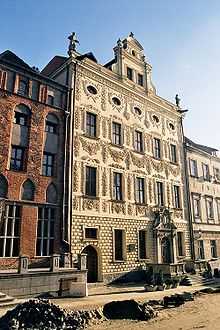
Inside the city itself, most of the population is concentrated on the right (northern) bank of the Vistula river. Two of the most densely populated areas are Rubinkowo and Na Skarpie, housing projects built mostly in the 1970s and 1980s, located between the central and easternmost districts; their total population is about 70,000.
Toruń and Bydgoszcz together make up a bipolar metroplex which, including those cities' counties and a number of smaller towns, may have a population of as much as 800,000. Thus the area contains about one third of the population of the Kuyavia-Pomerania region (which has about 2.1 million inhabitants).
Some groups of Japanese, Ukrainian and Vietnamese people live in Toruń now. The Japanese diaspora is the largest visible minority in the city; it stems from the management of businesses opened in recent years by Japanese companies such as Sharp. In additional to Japanese managers, engineers, translators, and their families; there are Japanese language teachers working at the local university and language schools, and people who have married locals and stayed in Toruń.
Transport

The transportation network in the city itself has been a subject of much criticism for years. Although the city proper is not very large, the underdeveloped street and road network is a source of problems. It has to deal not only with a traffic generated by Toruń itself, but also with heavy transit and metropolitan traffic. Even the construction of new wide avenues, both by reconstructing existing streets and by construction of others from scratch, has not been enough. The most serious problem, however, is that only a single car traffic bridge crosses the Vistula river inside the city's boundaries. The construction of beltways, and thus the reduction of the inflow of vehicles into the city, has helped significantly, but still the existence of only one downtown bridge causes serious transportation difficulties, especially traffic jams. The construction of another bridge, located 4 km (2.49 mi) east of the existing one, has been prepared and was to start in 2009, and most of the necessary funds were to be secured by the end of 2008. Yet, political rivalries and technical difficulties prevented constructions to go on as planned. The construction of the new bridge began in spring 2011 and is scheduled to be completed on July 4, 2013. <http://www.most.torun.pl/>
The city transport system is composed of 5 tram lines and about 40 bus lines, covering the city and some of the neighbouring communities.
Toruń is situated at a major road junction, one of the most important in Poland. The A1 highway reaches Toruń, and a southern beltway surrounds the city. Besides these, the European route E75 and a number of domestic roads (numbered 10, 15, and 80) run through the city.
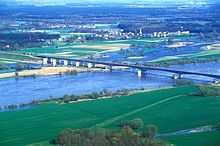
With three main railway stations (Toruń Główny, Toruń Miasto and Toruń Wschodni), the city is a major rail junction, with two important lines crossing there (Warszawa–Bydgoszcz and Wrocław–Olsztyn). Two other lines stem from Toruń, toward Malbork and Sierpc.
The rail connection with Bydgoszcz is run under a name "BiT City" as a "metropolitan rail". Its main purpose is to allow traveling between and within these cities using one ticket. A joint venture of Toruń, Bydgoszcz, Solec Kujawski and the voivodeship, it is considered as important in integrating Bydgoszcz-Toruń metropolitan area. A major modernization of BiT City railroute, as well as a purchase of completely new vehicles to serve the line, is planned for 2008 and 2009. Technically, it will allow to travel between Toruń-East and Bydgoszcz-Airport stations at a speed of 120 km/h (75 mph) in a time of approximately half an hour. In a few years' time "BiT City" will be integrated with local transportation systems of Toruń and Bydgoszcz, thus creating a uniform metropolitan transportation network - with all necessary funds having been secured in 2008.
Since September 2008, the "one-ticket" solution has been introduced also as regards a rail connection with Włocławek, as a "regional ticket". The same is planned for connection with Grudziądz.
Two bus depots serve to connect the city with other towns and cities in Poland.
As of 2008, a small sport airfield exists in Toruń; however, a modernization of the airport is seriously considered with a number of investors interested in it. Independently of this, Bydgoszcz-Szwederowo airport, located about 50 kilometres (31 miles) from Toruń city centre, serves the whole Bydgoszcz-Toruń metropolitan area, with a number of regular flights to European cities.
Economy

| Medieval Town of Toruń | |
|---|---|
| Name as inscribed on the World Heritage List | |
 | |
| Type | Cultural |
| Criteria | ii, iv |
| Reference | 835 |
| UNESCO region | Europe and North America |
| Inscription history | |
| Inscription | 1997 (21st Session) |
Although a medium-sized city, Toruń is the site of headquarters of some of the largest and most influential companies in Poland, or at least of their subsidiaries. The official unemployment rate, as of September 2008, is 5.4%.
In 2006, construction of new plants owned by Sharp Corporation and other companies of mainly Japanese origin has started in the neighboring community of Łysomice (about 10 kilometres (6 miles) from city centre). The facilities under construction are located in a newly created special economic zone. As a result of cooperation of the companies mentioned above, a vast high-tech complex is to be constructed in the next few years, providing as many as 10,000 jobs (a prediction for 2010) at the cost of about 450 million euros. As of 2008, the creation of another special economic zone is being considered, this time inside city limits.
Thanks to its architectural heritage Toruń is visited by more than 1.5 million tourists a year (1.6 million in 2007). This makes tourism an important branch of the local economy, although time spent in the city by individual tourists or the number of hotels which can serve them are still not considered satisfactory. Major investments in renovation of the city's monuments, building new hotels (including high-standard ones), improvement in promotion, as well as launching new cultural and scientific events and facilities, give very good prospects for Toruń's tourism.
In recent years Toruń has been a site of intense building construction investments, mainly residential and in its transportation network. The latter has been possible partly due to the use of European Union funds assigned for new member states. Toruń city county generates by far the highest number of new dwellings built each year among all Kuyavian-Pomeranian counties, both relative to its population as well as in absolute values. It has led to almost complete rebuilding of some districts. As of 2008, many major constructions are either under development or are to be launched soon - the value of some of them exceeding 100 million euros. They include a new speedway stadium, major shopping and entertainment centres, a commercial complex popularly called a "New Centre of Toruń", a music theater, a centre of contemporary art, hotels, office buildings, facilities for the Nicolaus Copernicus University, roads and tram routes, sewage and fresh water delivery systems, residential projects, the possibility of a new bridge over the Vistula, and more. Construction of the A1 motorway and the BiT City fast metropolitan railway also directly affects the city.
About 25,000 local firms are registered in Toruń.
Culture
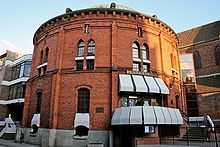
Toruń has two drama theatres (Teatr im. Wilama Horzycy with three stages and Teatr Wiczy), two children's theatres (Baj Pomorski and Zaczarowany Świat), two music theatres (Mała Rewia, Studencki Teatr Tańca), and numerous other theatre groups. The city hosts, among others events, the international theatre festival, "Kontakt", annually in May
A building called Baj Pomorski has recently been completely reconstructed. It is now one of the most modern cultural facilities in the city, with its front elevation in the shape of a gigantic chest of drawers. It is located at the south-east edge of the Old Town.
Toruń has a number (2) of cinemas including a Cinema City, which has over 2,000 seats.

Over ten major museums document the history of Toruń and the region. Among others, the "House of Kopernik" and the accompanying museum commemorate Nicolaus Copernicus and his revolutionary work, the university museum reveals the history of the city's academic past.
The Centre of Contemporary Art (Centrum Sztuki Współczesnej - CSW) opened in June 2008 and is one of the most important cultural facilities of this kind in Poland. The modern building is located in the very centre of the city, adjacent to the Old Town.
The Toruń Symphonic Orchestra (formerly the Toruń Chamber Orchestra) is well-rooted in the Toruń cultural landscape.
Toruń is equipped with a planetarium (located downtown) and an astronomical observatory (located in nearby community of Piwnice). The latter boasts the largest radio telescope in the Eastern part of Central Europe with a diameter of 32 m (104.99 ft), second only to the Effelsberg 100 m (328.08 ft) radio telescope.
Toruń is well known for Toruń gingerbread, a type of pierniki often made in elaborate moulds. Muzeum Piernika in Toruń is the only museum dedicated to gingerbread in Europe.
Education
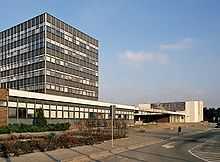
Over thirty elementary and primary schools and over ten high schools make up the educational base of Toruń. Besides these, students can also attend a handful of private schools.
The largest institution of higher education in Toruń, Nicolaus Copernicus University in Toruń serves over 40 thousand students and was founded in 1945, based on the Toruń Scientific Society, Stefan Batory University in Wilno, and Jan Kazimierz University in Lviv. The existence of a high-ranked and high-profiled university with so many students plays a great role the city's position and importance in general, as well as in creating an image of Toruń's streets and clubs filled with crowds of young people. It also has a serious influence on local economy.
Other public institutions of higher education:
- Wyższe Seminarium Duchowne (a section of the Theological Faculty of the Nicolaus Copernicus University)
- The Teacher Training College - Nauczycielskie Kolegium Języków Obcych (affiliated to the Nicolaus Copernicus University)
- College of Fashion (Kolegium Mody)
- University of Warmia and Mazury in Olsztyn - Faculty of Geodesy and Land Management Department in Toruń
- College of Social Work - Kolegium Pracowników Służb Społecznych
- University of Gdańsk - College of Language
There are also a number of private higher education facilities:
- Toruń School of Banking - Wyższa Szkoła Bankowa
- The University of Social & Medial Culture in Toruń - Wyższa Szkoła Kultury Społecznej i Medialnej (affiliate to the Radio Maryja)
- Toruńska Szkoła Wyższa
- Wyższa Szkoła Filologii Hebrajskiej (Higher School of Hebrew Philology)
- Toruń School of Entrepreneurship - Toruńska Wyższa Szkoła Przedsiębiorczości
Healthcare

Six hospitals of various specializations provide medical service for Toruń itself, its surrounding area and to the region in general. The two largest of these hospitals, recently run by the voivodeship, are to be taken over by Nicolaus Copernicus University and run as its clinical units. At least one of them is to change its status in 2008, with the formal procedures being very advanced.
In addition, there are a number of other healthcare facilities in the city.
Media
- TV Stations:
- TVN/TVN24 - regional office,
- TVP Info - Oddział w Bydgoszczy, Redakcja Terenowa w Toruniu,[8]
- Telewizja Trwam
- Podróże TV,
- Telewizja Kablowa Toruń
- Telewizja TAT Studio Region ,
- Telewizja Petrus
- Radio Stations:
- Polskie Radio Pomorza i Kujaw,
- Radio ESKA, - which plays international hits, along with Polish music.
- Radio GRA,
- Radio ZET Gold,
- Radio Sfera,
- WAWA,
- RMF FM
- Radio Maryja - a radio station that is centred around religious observances, such as mass, and prayer, in Polish.
- Press
- daily newspapers: Nasz Dziennik, Rzeczpospolita, Gazeta Wyborcza Toruń, Gazeta Pomorska, Nowości, Metro
- Weekly magazines: Niedziela, City Toruń, Teraz Toruń,
- Other: Undergrunt, Immuniet, Ilustrator, Poza Toruń
Sports clubs
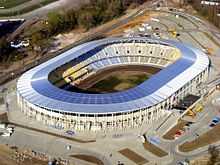
- Unibax Toruń - motorcycle speedway who ride in the Speedway Ekstraliga, Polish Champions four times
- Toruński Klub Piłkarski (former ZKS Elana Toruń) - football (3rd division in Poland)
- Angels Toruń - American football - Polish American Football League
- Nesta Toruń - ice hockey (collapse of the financial)
- Pomorzanin Toruń - field hockey (premier league in Poland), football (4th division in Poland), box
- Nestle-Pacyfic - cycling
- Toruński Klub Bowlingowy - bowling
- Energa Toruń - basketball (women premier league in Poland)
- TKS-T Budowlani Toruń - volleyball (women 1st league in Poland)
- Siden Polski Cukier Toruń - basketball (men 1st league in Poland)
Notable residents
International relations

Bulwar Filadelfijski (Philadelphia Boulevard), both a 2 km (1.2 mi) long street running mostly between Vistula River and walls of the Old Town, and the boulevard itself (bearing the same name), honours sister relationship with Philadelphia, Pennsylvania.
Ślimak Getyński (Goettingen Helix, German: Goettingen Schnecke) is one of the lanes connecting Piłsudski Bridge / John Paul II Avenue with Philadelphia Boulevard at their downtown interchange. It honours the relationship with Göttingen, its name derived from the street's half-circular shape (Polish word ślimak meaning "snail").
Twin towns — Sister cities
|
National senators
- Andrzej Person (Senate)
- Jan Wyrowiński (Senate)
- Michał Wojtczak (Senate)
European deputies
Current Member of the European Parliament (MEP) elected from the Kuyavian-Pomeranian constituency:
- Tadeusz Zwiefka, EPP-ED
Miscellanea
- Depending on the method of calculation, the Geographic Centre of Europe may be at Toruń.
Gallery
-

City Hall
-

Old Town
-
View from Piłsudski Bridge
-

St. James's Church
-

Bridge over the Vistula
-

St. Mary's Church
-

Queen Jadwiga Street (ulica Królowej Jadwigi), New Town
See also
Notes
- ↑ Ohngren, Kara. "Interview with Mr. Michał Zaleski, Mayor of Torun, Poland". CEOWORLD Magazine. Retrieved 23 April 2013.
- ↑ Hypothetical reconstruction of a Lusatian culture settlement, built using bronze age tools: Wola Radziszowska, Poland, part of a study by scientists from the Jagiellonian University’s Institute Of Archaeology.
- ↑ 3.0 3.1 Encyklopedia Powszechna PWN Warsaw 1976
- ↑ "Krzyżacy - założyciele Torunia" (Teutonic Knights — the founders of Thorn). (Internet Archive) Urząd Miasta Torunia. "The foundation charter for Thorn was signed on 28th December 1233 by the Grand Master of the Teutonic Order Herman von Salza and the National Master for Prussia and the Slavonic Lands Herman Balka. In that way Thorn was founded by the Teutonic Order and managed by the Knights until 1454." Retrieved June 16, 2013.
- ↑ Max Töppen Historisch-comparative Geographie von Preussen: Nach den Quellen, namentlich auch archivalischen, J. Perthes, 1858; PDF
- ↑ Bahlcke, Joachim (2008). Daniel Ernst Jablonski; Religion, Wissenschaft und Politik um 1700 (in German). p. 227. ISBN 978-3-447-05793-6.
- ↑ Maciej Kołyszko (2013). "Zarys historii Torunskiej mniejszosci Żydowskiej (History of Jews in Torun)". Żydzi z Torunia. Cmentarze Żydowskie w Polsce. Retrieved 2013-06-16.
- ↑ "Tvp Bydgoszcz". Ww6.tvp.pl. Retrieved 2009-05-06.
- ↑ 9.0 9.1 9.2 9.3 9.4 9.5 9.6 9.7 9.8 9.9 9.10 "Miasta bliźniacze Torunia" [Toruń's twin towns]. Urząd Miasta Torunia [City of Toruń Council] (in Polish). Retrieved 2013-08-22.
- ↑ "Heritage Twin Towns". © 2003-2009 Swindon Borough Council. Retrieved 2009-02-16.
- ↑ "Torun - Twin Town in Poland". www.swindon.gov.uk. Retrieved 2009-11-07.
External links
| Wikimedia Commons has media related to Toruń. |
| Wikisource has the text of the 1921 Collier's Encyclopedia article Thorn (town). |
- Municipal website
- What's on in Toruń
- VisitTorun.pl tourism
 Torun travel guide from Wikivoyage
Torun travel guide from Wikivoyage- Guide about Kujawy and Włocławek in Toruń area






